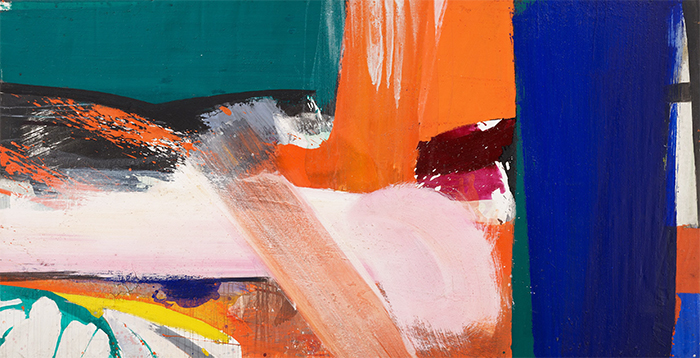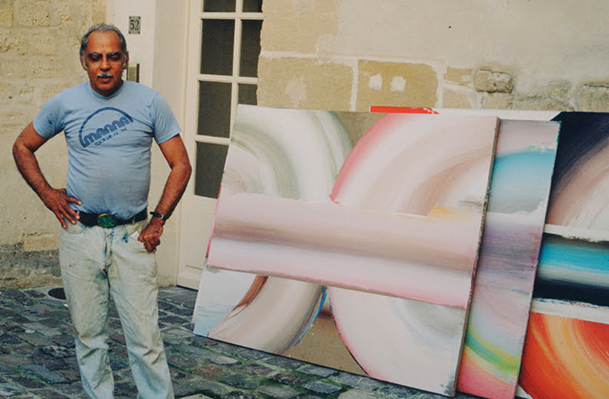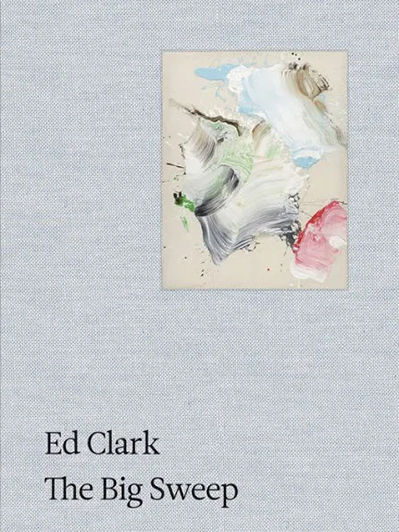추상표현주의 화가 에드 클락(Ed Clark) 회고전과 전기 출간-하우저앤워스 갤러리
에드 클락(Ed Clark: The Big Sweep) @하우저앤워스(9/7-10/21)
붓 대신 빗자루로 작업...역동적인 파워와 에너지 담아

"단도직입적으로 생존해 있는 최고 화가 중 한명이다."
"노력한 흔적이 없이 떠도는 빛으로 가득한 스릴 넘치는 추상"
백인 남성 중심의 추상표현주의학파 뉴욕스쿨에서 소외되었던 화가 에드 클락(1926-2019)이 재조명된다. 에드 클락의 회고전 'Ed Clark: The Big Sweep'이 9월 7일부터 10월 21일까지 첼시 하우저앤워스(Hauser & Wirth) 갤러리에서 열린다. 하우저앤워스 출판사는 이와 함께 그의 전기 ‘Ed Clark: The Big Sweep; Chronicles of a Life, 1926–2019’를 출간한다.
에드 클락은 뉴올리언스에서 철도국 직원과 재봉사 부부 사이에서 태어났다. 아버지는 도박꾼이기도 했다.(Animals-"House of Rising Sun") 에드가 6살 때 가족은 바톤 루즈의 화장실과 전기가 들어오지 않는 집으로 이사했다. 이후 시카고에서 자랐으며, 제 2차 세계대전 때 공군으로 괌에서 복무했다.
난독증이 있었지만, 그림에 소질이 있었던 에드 클락은 시카고아트인스티튜트에 들어갔다. 졸업 후 파리가 미술의 중심지라는 말을 듣고, GI 빌(*참전용사 장학금)을 받아 파리 몽파르나스의 미술학교 아카데미 드 라 그랑 쇼미에르(Académie de la Grande Chaumière: 이성자 화백 모교)에서 수학했다. 1956년 파리 시절 에드 클락은 흑인 소설가 제임스 볼드윈 등 보헤미안들과 어울리면서 캔버스를 작업실 바닥에 놓고, 빗자루로 그리기도 했다. 이 작업은 붓으로는 얻을 수 없는 역동적인 파워와 에너지를 담아냈다.
1957년 뉴욕으로 돌아가 10스트릿갤러리(저예산의 화가 운영 갤러리 연합)에 참가했다. 시드니 재니스 갤러리에서 조수로 일하면서 화가 마크 로스코가 갖고 있던 낡은 캔버스를 받아 그리기도 했다. 1958년 뉴욕에서 첫 개인전을 열었으며, 이후 파리와 뉴욕을 오가면서 활동했다. 1968년 세번째 부인 헤디 더햄과 파리 근처 베튜이유에 사는 추상화가 조안 미첼(Joan Mitchell)의 집에 1년간 머물면서 작업했다. 이 시절에 타원형 캔버스를 사용했으며, 1969년엔 파리의 미 대사관에서 전시했다.
1972년 뉴욕에 돌아온 후 에드 클락은 미니멀 조각가 도날드 저드(Donald Judd)가 운영하는 스프링스트릿 로프트에서 개인전을 열었다. 1973 휘트니 비엔날레에 참가했으며, 그후 MoMA와 휘트니에 작품이 소장됐다.
2014년 맨해튼 어퍼이스트사이드의 틸튼 갤러리(Tilton Gallery)에서 열린 에드 클락의 개인전 'Ed Clark: Paintings'(1/10-2/18)에 대해 비평가 배리 슈와브스키 "그는 단도직입적으로 말해, 생존해 있는 최고 화가 중 한명이다... 문자 그대로 육체적인 존재감으로 그리며, 화가의 정신적 육체적 활동의 흔적으로서 빛의 영광을 불러일으키는 것으로부터 분리할 수 없다"고 평했다.
Ed Clark: The Big Sweep
Beginning 7 September, two full floors of Hauser & Wirth’s 22nd Street building in New York will be devoted to ‘The Big Sweep,’ an exhibition covering the six-decade career of pioneering American abstractionist Ed Clark (1926 – 2019). Taking its title from Clark’s dedication to innovative techniques, particularly his revolutionary embrace of the common push broom as a paintbrush, this presentation documents the ways in which Clark pushed the boundaries of abstraction and its conventions beyond expressionism, from his breakthrough introduction of the shaped canvas to his distinctive approach to and impact upon questions of materiality, form and color.
‘The Big Sweep’ exhibition will be accompanied by the release of ‘Ed Clark: The Big Sweep; Chronicles of a Life, 1926–2019,’ the definitive new book on Clark, produced by Hauser & Wirth Publishers.
Among the exceptional works on view, the earliest is ‘Untitled’ (1955). Completed while Clark was living in Paris, this canvas reflects the direction of the artist’s early practice under influences he encountered upon arriving in Europe in 1952, after studying at the Art Institute of Chicago. Here, he has created a work at once in dialogue with the art of his contemporaries, while expressing a velocity discernably his own. In Paris, Clark surrounded himself with such luminary American peers as Beauford Delaney, Sam Francis and Joan Mitchell, while likewise finding profound inspiration in the paintings of French artist Nicolas de Staël. Released from the bigotry and racialized assumptions that burdened Black artists in the United States, Clark felt liberated from the focus on realism that had dominated his practice back home. He began to experiment with abstraction, and to lean into the central role gesture and the tangibility of paint could play in practice. Of this period, he said, ‘I began to believe, from my conversations with other artists, that the real truth is in the stroke. For me, it is large, bold strokes that do not refer distinctly to seen nature. The paint is the subject. The motions of the strokes give the work life.’
Clark returned to the United States in 1956 and quickly established himself in the New York School alongside Al Held, Franz Kline, Yayoi Kusama and George Sugarman, among others. In 1957, he broke away from the limitations of the traditional rectangular canvas and created the first shaped painting in American modernism, now in the collection of the Art Institute of Chicago. By including protruding collage elements in his paintings, he immediately endowed his work with a bold, palpable physicality. In 1967, Clark spent a year living at Joan Mitchell’s home and studio in Vétheuil, France, where he painted his first oval canvas, mimicking the shape of the human eye, and using a push broom to create large sweeping brushstrokes. The monumental ovoid canvas of ‘Untitled’ (c. 1970s)––on view in this exhibition––as well as the embedded oval shape of ‘Integrated Oval #1’ (1972)—exhibited in the Whitney Annual that same year—both suggest the pleasure and sense of freedom Clark achieved through the formal experimentation that in turn allowed him to intensify his gesture and the effects of materiality, form and color.
Clark would become renowned for his revolutionary use of a push broom as a paintbrush, a technique he first tried in Paris in 1956 and that, along with the shaped canvas, would come to define his practice. The push broom offered the artist a way to imbue his work with dramatic degrees of dynamism and energy that could not be realized by a conventional paintbrush. As demonstrated in such paintings as ‘Locomotion’ (1963) and ‘North Light (Paris)’ (1987), Clark’s method used the pressure of his entire body—he described the effect as being akin to ‘cutting through something really fast; that’s what the straight stroke with the push broom gives you, speed’— to evenly extend the momentum of his sweeping gesture across the whole surface of the canvas. Though Clark would occasionally vary the intensity of the line and color in a single motion, exploring nuances in its effects, the power of this revolutionary approach opened new vistas for abstraction with a big sweep.
By the 1980s, Clark had morphed the linearity of his earlier paintings into more tubular motifs that curved and splintered around the canvas. This ‘Broken Rainbow’ series is characterized by rounded brushstrokes that expand upon the curved lines of the 70s ovals with a new energy and confidence. Sometimes applying dry pigment to a wet broom, Clark injected his sweeping gestures with even greater motion and liveliness. In his late paintings, made in the first years of the 21st century, such as ‘Creation’ (2006), Clark’s forceful broom strokes gave way to softer, at times even aqueous, gestures that expressed a final burst of pure liberation.
Released in conjunction with the exhibition, ‘Ed Clark: The Big Sweep; Chronicles of a Life, 1926–2019’ (Hauser & Wirth Publishers) chronicles the story of the artist’s life and work through reprints of important historical texts by numerous authors, including Darby English, Anita Feldman, Geoffrey Jacques, Kellie Jones, April Kingsley and Corinne Robins; interviews with Clark by Quincy Troupe, Jack Whitten and Judith Wilson; and photographs, letters and ephemera from the archive of Clark’s estate and his papers at the Archives of American Art, Smithsonian Institution, Washington, D.C.

About the artist
Born in New Orleans in 1926 and raised in Chicago, Clark emerged in the 1950s as a pioneer of the New York School. Over the course of seven decades, his experimentations with pure color, abstract form, and the seductive materiality of paint have yielded an oeuvre of remarkable originality, extending the language of American abstraction. Clark’s breakthroughs have an important place in the story of modern and contemporary art: in the late 1950s he was the first American artist credited with exhibiting a shaped canvas, an innovation that continues to reverberate today. His search for a means to breach the limitations of the conventional paintbrush led him to use a push broom to apply pigment to canvas laid out on the floor. Defying the discreet categories of gestural and hard-edged abstraction, Clark has masterfully interwoven these approaches into a unique form of expressionism.
After studying at the Art Institute of Chicago and L’Academie de la Grande Chaumiere in Paris, Clark continued to live and work in France, absorbing the influence of such European modernists as Nicolas de Staël, Pierre Soulages, and Jean Riopelle. He became a member of a social and intellectual circle of American expatriate artists and writers, including fellow African-American creatives Beauford Delaney, Richard Wright, James Baldwin, and Barbara Chase-Riboud. Clark settled in New York in 1957, where over the ensuing decade he became part of the city’s dynamic downtown scene and a co-founder of the Brata Gallery, an artist-run cooperative among the Tenth Street galleries of the East Village. From the late 1960s until the last decade, Clark split his time between New York and Paris, traveling extensively to other locales from Mexico and Brazil to North Africa and Greece. In 2019, while living in Detroit, Clark passed away at the age of 93. ‘No matter what I do,’ the artist said, ‘there’s not a day that I’m not an artist.’

Ed Clark: The Big Sweep: Chronicles of a Life, 1926-2019
by Ed Clark (Photographer), Jake Brodsky (Editor), John Yau (Text by), Franklin Sirmans (Text by), Corinne Robins (Text by)
A visual biography of the influential American abstractionist and pioneer of the shaped canvas, with interviews, ephemera and historical documents
From his pioneering use of painting tools such as push brooms to his innovation of the shaped canvas, the impact of artist Ed Clark’s (1926–2019) work on the course of abstract painting in America was profound. On both sides of the Atlantic—in New York and in Paris—Clark witnessed and participated in myriad pivotal developments in mid to late 20th-century art history, counting artists such as Willem de Kooning, Beauford Delaney, Joan Mitchell and David Hammons among his friends and acquaintances.
This publication recounts the story of Clark’s art, life and career through reprints of important historical texts and interviews with the artist, as well as photographs, letters and ephemera from his archive.
Product Details
ISBN-13: 9783906915777
Publisher: Hauser & Wirth Publishers
Publication date: 10/10/2023
Pages: 248
Product dimensions: 7.25(w) x 9.25(h) x 0.00(d)
*휘트니뮤지엄의 흑인 거장들 <1> 에드 클락(Ed Clark, 1926-2019), 2021
https://www.nyculturebeat.com/index.php?mid=Art2&document_srl=4041604






추상화는 이해하기가 힘들어서 멀리 했습니다. 그런데 빗자루로 그림을 그린다니 흥미가 당깁니다. 올려주신 에드 클락의 몇점의 그림을 봤습니다. 색상이 연하면서 꿈을 꾸는 듯한 느낌을 줍니다. 실제로 보면 더욱 그런 느낌을 받을 것같습니다.
-Elaine-